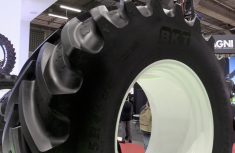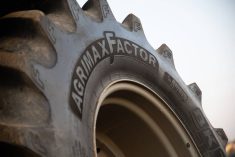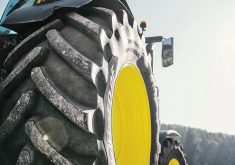Keeping perfect pressure | Inflation system keeps tire pressure up, down and equalizes pressure on all wheels
A system that automatically maintains correct pressures has replaced the archaic practice of using a hammer to check for soft tires.
TireMaax Pro from trailer manufacturer Hendrickson International differs from other automatic tire inflation systems (ATIS) by handling over-inflated tires as well as under-inflated tires. It also balances the pressures on duals.
Over-inflated tires are harder, making them susceptible to punctures, impact breaks and tread cutting. Tread wear is accelerated by as much as 15 percent.
Not only does over-inflation lead to early replacement, but safety is also compromised because of reduced traction in steering and braking.
Read Also

India slaps 30 per cent import duty on yellow peas
India has imposed a 30 per cent duty on yellow pea imports with a bill of lading date on or after Nov. 1, 2025.
On duals, a five pound per sq. inch discrepancy between the two tires can make the higher pressure tire grow 5/16 of an inch in circumference.
The tire with the higher pressure carries most of the load because it is bigger, which leads to premature failure.
The smaller tire is pulled along, scuffing and dragging against high spots on the road, which also leads to premature failure.
Hendrickson’s field data highlights the economic implications of this difference. It shows that nearly 25 percent of all highway trailers have duals with mismatched pressures greater than five p.s.i., which represents a lot of premature trips to the tire shop.
The U.S. Environmental Protection Agency says ATIS can extend tire life by eight percent, which means $80 for each high-end $1,000 trailer tire.
The American Trucking Association’s Technology Council has found that truck tires can lose up to two p.s.i. per month by diffusion through the inner liner and casing, which is another good reason for investing in a quality ATIS.
Mark Slingluff of Hendrickson said in an email that the TireMaax Pro is the only ATIS in the industry capable of equalizing p.s.i. in all eight trailer tires.
He said part of the problem is that conventional ATIS tops up tire pressures with air at the ambient temperature.
In the winter, the new air going into the tire is cold and dense and tires will have the correct p.s.i. as long as the ambient temperature doesn’t change.
However, the tire pressure rises in the spring as the air inside the tires warms and expands. The tires end up with too much pressure, which conventional ATIS can’t relieve.
The extreme temperature shifts on the Prairies between summer and winter can result in tire pressure deviations greater than 20 p.s.i. if adjustments aren’t made from season to season.
The situation is the same when driving from one temperature range to another, which is especially problematic on rigs that do a lot of north-south hauling in the winter.
Hendrickson’s field data shows that the maximum p.s.i. with inflate-only ATIS ranges from 121 to 123 p.s.i. on tires with a recommended maximum of 110 p.s.i.
With TireMaax Pro, maximum pressures on all eight tires remained constant at 109 p.s.i. in all conditions.
TireMaax Pro controls tire p.s.i. by allowing air to flow in both directions. It inflates low tires, relieves pressure from over-inflated tires and equalizes pressure across all wheel positions on the trailer.
However, unlike the Tire Boss system, it does not allow the driver to adjust pressures from the cab while driving, nor does it allow ultra-low pressures for better flotation when working in muddy fields.
The tire pressure range is pre-set at the factory to the desired cold tire pressure. After that, the controller automatically maintains pressures within that range on all eight tires, regardless of ambient temperature changes.
“A single controller can control from one to four axles,” he said. “The kit is configured in a manner that the customer receives the appropriate amount of axles, hubcaps and tire hose components required, based on the number of axles specified.”
Slingluff said each kit addresses all the tires on the trailer.
“The TireMaax was designed with the NAFTA (North American Free Trade Agreement) highway in mind,” he said.
“It can manage tire pressures in the winter from northern Canada all the way to Mexico without the driver having to stop to adjust tire pressures. The system draws from the trailer air supply to keep the trailer tires properly inflated and rolling smoothly.”
Keeping tires inflated is a major job for the seals in any ATIS. A typical trailer hub assembly makes about 500 revolutions per mile, which is 50 million revolutions in 100,000 miles.
That’s a lot of spinning for a seal that has to hold 120 p.s.i. without failure.
“TireMaax Pro uses its own unique hubcap,” Slingluff said.
“We leveraged almost 10 years of rotary union experience to develop the current system. It relies on an extreme duty elastomeric seal and robust ball bearings.
“The rotary union and tire hose connections are integrated into the hubcap design to simplify component packaging at the wheel ends. The hubcap is non-vented, eliminating a contaminant pathway and works in tandem with Hendrickson’s patented axle ventilation system to provide a protected wheel ventilation path.”
For more information, visit www.hendrickson-intl.com.
















